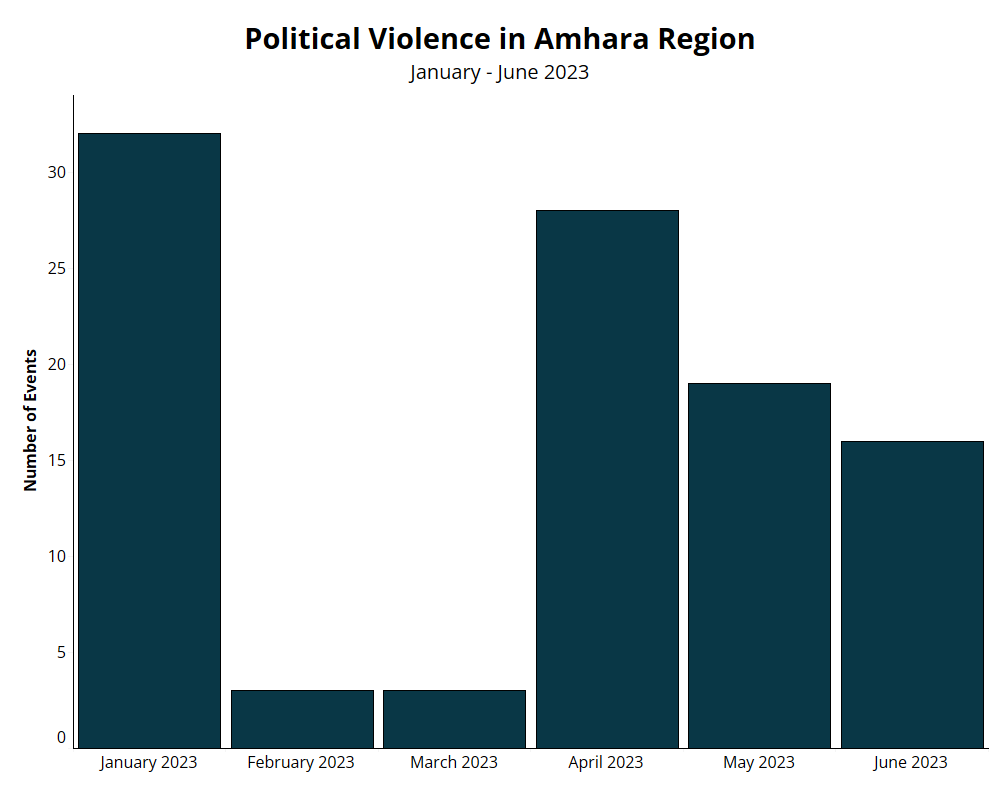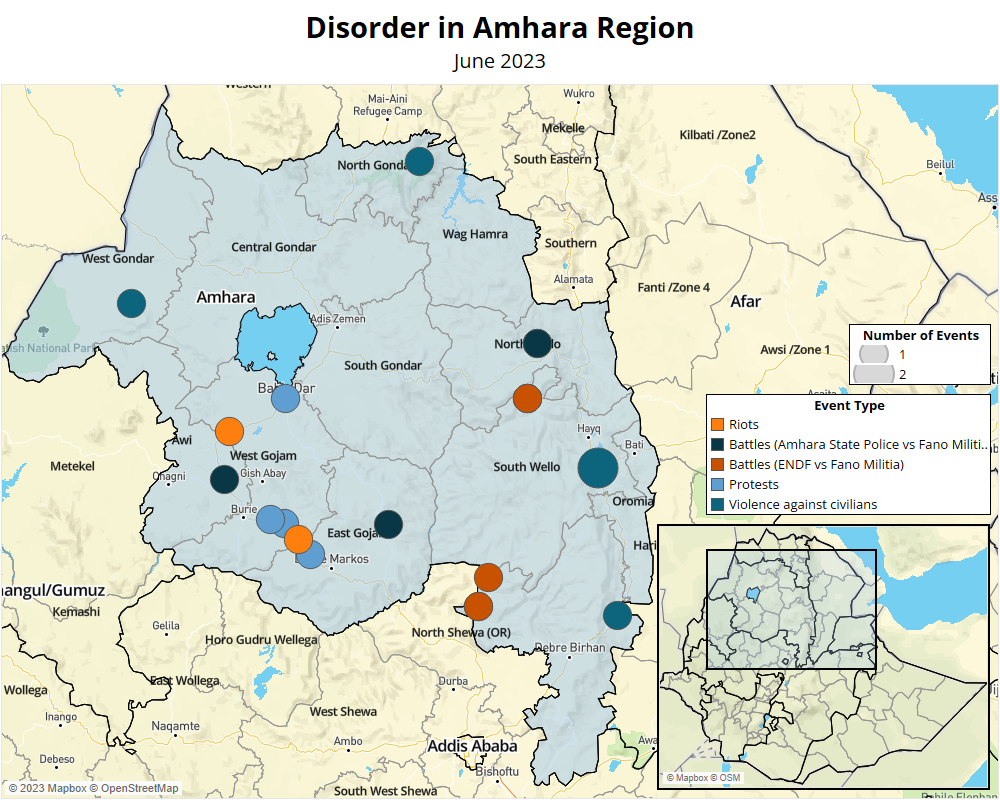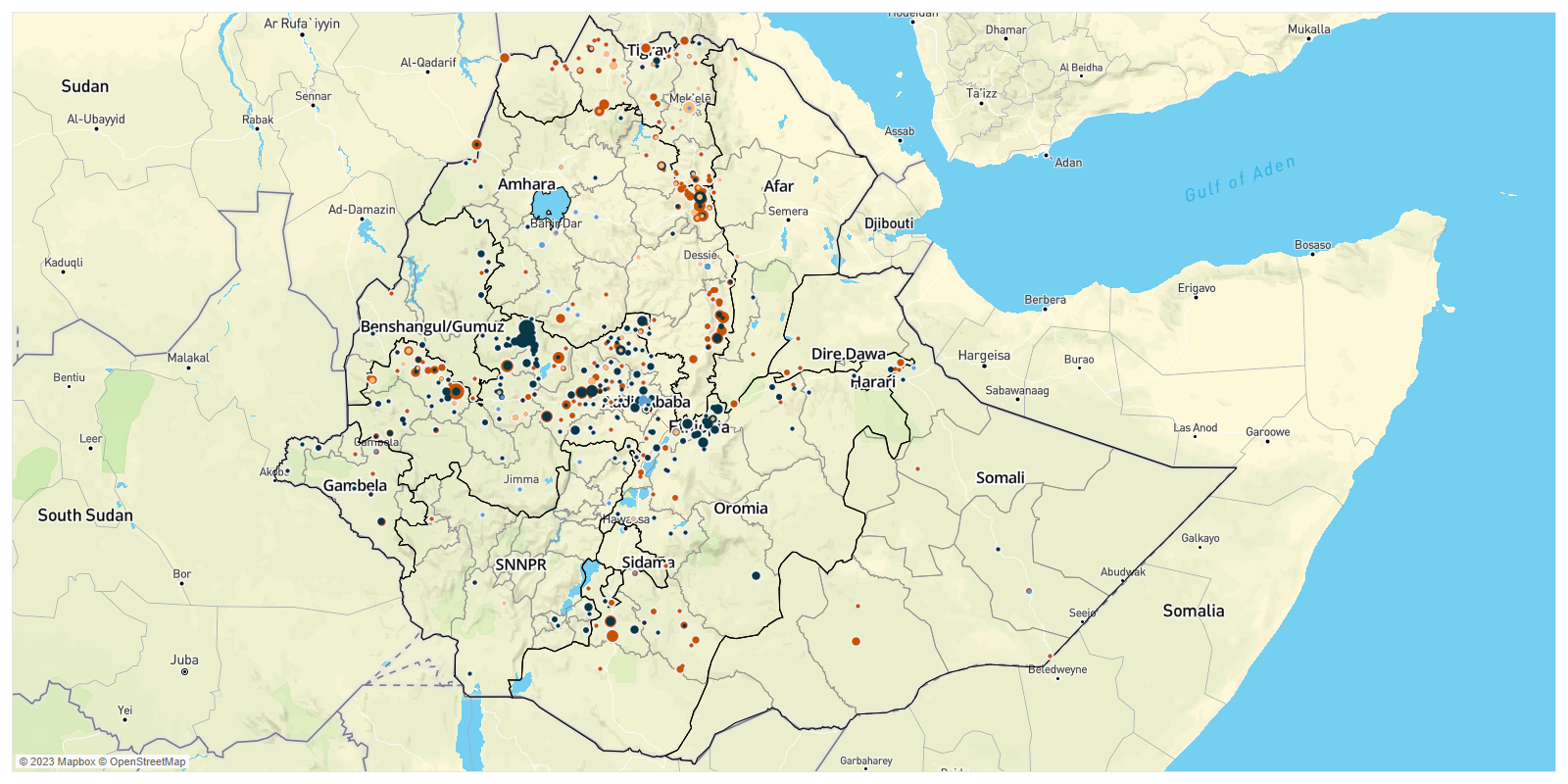IN THIS REPORT
- June at a Glance
- Vital Trends
- Key Developments
- Monthly Focus: Political Violence Declines in Amhara Region Following Government Crackdown
June at a Glance
VITAL TRENDS
- In June, ACLED records 78 political violence events and at least 226 reported fatalities. Of these, 56 were civilian targeting events, which saw a 40% increase compared to May.
- Oromia region had the highest number of recorded events and reported fatalities due to political violence in June, with 55 events and at least 182 reported fatalities. Oromia region also had the highest number of violence targeting local administrators incidents in the country, with the majority – three out of five – reportedly perpetrated by the Oromo Liberation Front (OLF)-Shane.
- In June, the most common event types were violence against civilians, with 51 events, and protests, accounting for 32 events. Half the recorded protest events in the country occurred in Tigray region, where ethnic Amharas held mass protests asking that their ethnic identity be considered in governance.
KEY DEVELOPMENTS

Monthly Focus: Political Violence Declines in Amhara Region Following Government Crackdown
Despite rising political tensions in the past three months, Amhara region continued to trend downward in recorded political violence events throughout June (see graph below). Following widespread disorder in April after the disarmament of the Amhara regional special forces and clashes associated with an Amhara nationalist militia in May, June only saw limited clashes and some demonstrations. Significantly, despite high tensions over the political direction of the country and grievances against the government in Amhara region, the overall levels of violence are much lower compared to Oromia region (for more information, see the EPO Monthly: May 2023).

On 6 April, the Ethiopian government declared its intention to incorporate regional special forces from each region of the country into different branches of the security sector. This move sparked riots and protests throughout Amhara region (see the EPO Monthly: April 2023 for more details). Those opposing the move called it “untimely” and accused the government of leaving Amhara region “vulnerable” to attacks.1National Movement of Amhara, ‘A statement from the Amhara National Movement (ABN) on current issues,’ 11 April 2023 This sentiment alludes to a commonly-held concern in Amhara region after the northern conflict spilled into the region, causing enormous damage to public and private properties. The situation escalated throughout the month, culminating in the assassination of the head of the Amhara Prosperity Party as he traveled from Mehal Meda to Debre Birhan. The Ethiopian National Defence Force (ENDF) was deployed to various towns in the region, leading to 15 recorded incidents of armed clashes with Amhara militias, Fano, and members of special forces in at least 12 locations in April and May. At the end of May, the ENDF engaged in a four-day-long clash with militants from the Amhara Popular Front (AFP), which had fortified themselves within the Debre Elias Bihere Betsuan Melka Silase Andent Monastery in Degolma kebele in Debre Elias woreda, East Gojam zone. The government identified the former chairperson of the Balderas Party and journalist, Eskinder Nega, as being primarily responsible and claimed that 200 members of the AFP had been killed during the operation2Ethiopian Broadcasting Corporation, ‘The Security and Safety Joint Task Force announced that the action taken against Eskinder Nega and his accomplices, who were working to overthrow the government through armed struggle, in the Selase Gedam fortress of Debre Elias Woreda, East Gojam Zone, has defeated their plot to destabilize the region,’ 3 June 2023 (for more on the events in Debre Elias, see the EPO Weekly: 27 May-2 June 2023).
The government’s crackdown in Amhara region against Amhara nationalist actors appears to have been quick and decisive. The grievances related to the presence of federal security forces in Amhara region, among other issues, held by groups and armed militias have the potential to develop into a more serious insurgency. However, the lack of more widespread battle events in June may suggest that the government’s swift crackdown against Amhara nationalist actors in April and May has successfully deterred more militant activity in the region. In contrast to Oromia region, where the OLF-Shane insurgency has had many years to develop, violent anti-government groups in Amhara region are new and immature, lacking widespread coordination. The ENDF deployment has nonetheless sparked complaints by opposition parties in parliament and demonstrations in many towns.
Government Crackdown on Amhara Nationalists
Amhara nationalism is not a new phenomenon. The rise of modern Amhara ethno-nationalists is rooted in the establishment of the Welkait-Tegede Identity Committee. The committee was formed in 2015 and advocated for the ethnic rights of Amharas living in the Welkait and Tegede areas of Tigray region governed by the Tigray People’s Liberation Front (TPLF).3Sonja John, ‘The Potential of Democratization in Ethiopia: The Welkait Question as a Litmus Test,’ Journal of Asian and African Studies, 2 August 2021 The northern Ethiopia conflict provided an opportunity for various Amhara groups to gain military experience, receive weapons, and organize. Following the conflict, demands from these groups concerning Western Tigray, peace negotiations with the TPLF, and disarmament of Fano militias have led to a re-alignment, pitting pro-Amhara nationalist militias against government forces.
As the northern conflict has drawn to an end, the government’s response to Amhara nationalist actors has been a strong crackdown, including establishing a strong military presence in many towns in the region and conducting arrests. On 8 June 2023, the federal government announced that it filed terrorism charges against 51 individuals, many of them prominent media figures with pro-Amhara nationalistic political leanings that had expressed opposition to the ENDF’s presence in Amhara region.4Ethiopia Insider, ‘The list of terrorist charges filed against 51 individuals by the prosecutor and the court appearance of the defendants,’ 13 June 2023 Additional charges have been brought against various Fano militia leaders, many of whom are being held in prison.5Addis Standard, ‘News: Court acquits Fano militia leader Zemene Kase as federal security taskforce claims to squash new insurgency in Amhara region,’ 5 June 2023 The crackdown by the federal government has also reportedly included incidents of forced disappearance.6EHRC, ‘Enforced Disappearance, which is increasing in Ethiopia, should be stopped immediately,’ 5 June 2023 The Amhara regional government – which is dominated by the ruling Prosperity Party officials – has indicated its alignment with the federal government and implemented directives from Prime Minister Abiy Ahmed, including the integration of the special forces and a continuation of the peace process with the TPLF, despite opposition from the general public. On 11 June, a delegation from the TPLF visited Bahir Dar, and met with Amhara regional officials, to discuss future peace between Tigray and Amhara regions.7VOA Amharic, ‘Tigray interim administrators enter Bahir Dar,’ 11 June 2023; Amhara Media Corporation, ‘”The discussion laid the foundation for establishing peace between the two regions,” said Gezashew Muluneh,’ 14 June 2023
Reactions to Government Crackdown in Amhara Region
The ENDF’s presence in Amhara region has been highly contested. Communities have protested their presence, leading to escalated tensions and heightened grievances as the arrests of local Fano leaders by government security forces have been violent. As per the constitution, federal forces should only be allowed to deploy to a region by invitation of the regional government at the time of deteriorating security beyond the capacity of the regional security forces.8Constitution of the Federal Democratic Republic of Ethiopia Proclamation No. 1/1995, 1995, Article 51 (14) In this case, the Amhara regional government never officially called on the federal government to intervene. On 28 April, the Joint Peace and Security Task Force, which consists of various federal security sectors, released a statement clarifying that the ENDF’s presence in Amhara region was to target “extremist forces” allegedly trying to take power in the region through force.9Ethiopian Federal Police, ‘The Joint Peace and Security Task Force announced that it is taking decisive action against the extremist forces that are trying to control the regional power by destroying the constitutional system in the Amhara region,’ 29 April 2023 The regional government defended the presence of the ENDF and condemned “false narratives” spreading opposition to their presence.10Amhara Media Corporation, ‘A statement from the Amhara National Regional Government Peace and Security Office on current issues,’ 2 May 2023 On 8 June, members of parliament from the National Movement of the Amhara (NaMA) called on the federal government to remove federal troops from the region.11VOA Amharic, ‘The National Defense Force, which entered the Amara region in the name of law enforcement, was asked to return,’ 7 June 2023 On 9 June, a cross-regional coalition of Ethiopia’s opposition parties denounced the security situation in the country, specifically mentioning Amhara region, and asking the government to take corrective measures to improve the situation.12Deutsche Welle Amharic, ‘The call of the joint council of Ethiopian political parties,’ 9 June 2023
The Amhara public response to the federal government’s crackdown on Amhara nationalist actors and organizations has been the cause of disorder, including limited battles and demonstrations in several locations (see map below). On 11 June, ENDF forces entered Dembecha town looking for Eskinder Nega, prompting a violent demonstration against the federal army’s presence in the town. Five people were reportedly killed during the demonstration, including two ENDF soldiers and three demonstrators, after ENDF soldiers opened fire on the crowd. Similarly, also in Delanta woreda in North Wello zone, on 21 June, demonstrators mobilized, and federal soldiers engaged in a firefight with Fano militiamen after allegations spread that one of the soldiers had raped a young girl.

Wider discontent with the government and ruling Prosperity Party was also expressed throughout the month, with farmers in the region accusing the government of withholding fertilizer supplies in a series of demonstrations in the region’s capital in June.13DW Amharic, ‘Following the shortage of fertilizers in Amhara region, farmers in Debremawi Kebele area of Yilmana Densa district of West Gojam zone are cracking whips in Bahir Dar city,’ 31 May 2023 On 19 June, residents of Amanuel town blocked highways and denounced the government’s lax security measures in Oromia region after suspected OLF-Shane members abducted several drivers from the town. One person was killed and four others injured when Amhara state police fired into the crowd.
While grievances are high, anti-government militias in Amhara region are fractured and do not appear to be organized enough to mount a serious insurgent challenge to the government. Unlike in Oromia region, where the OLF-Shane insurgency branched from the OLF and inherited the Oromo ethno-nationalist mandate, Amhara region does not have a strong history of insurgency, and local militias do not have strong connections. Compounded with the federal government’s swift response, these factors can explain the overall reduction in reported political violence activity despite a high level of grievances.
The government’s operations in Amhara region have been an effective, heavy-handed response to Amhara nationalism actors. Despite the unrest and some limited armed clashes as a response to the government crackdown, the situation in Amhara region has stabilized, and violent incidents were less common in June than in either April or May. Arrests, clashes, and the deployment of federal military forces have led to a decrease in reported violent incidents. However, grievances remain high in Amhara, and have increased with the deployment of the federal army to the region – to the disapproval of several communities. Amhara diaspora organizations, like the Amhara Association of America, have denounced the government’s actions in the region and called for accountability.14AAA, ‘Killings and physical injuries of civilians by the Oromo dominated ENDF in Dembecha, Jiga and Finote Selam towns (West Gojjam Zone, Amhara Region, Ethiopia) on June 11 and 12, 2023,’ 27 June 2023 While the ENDF’s presence in the region may have temporarily delayed any wider spread of violence, it is not a permanent solution, and clashes are likely to return.






